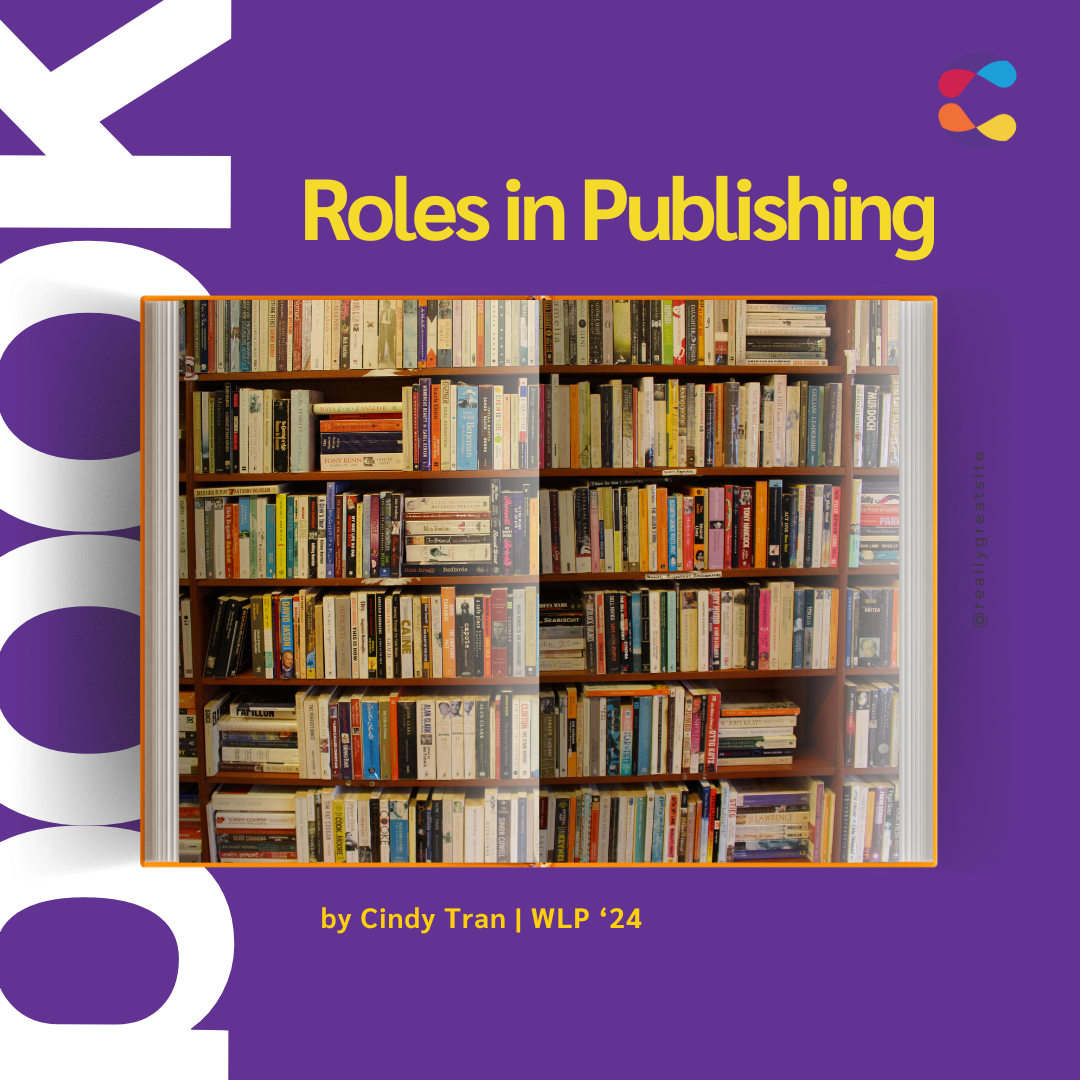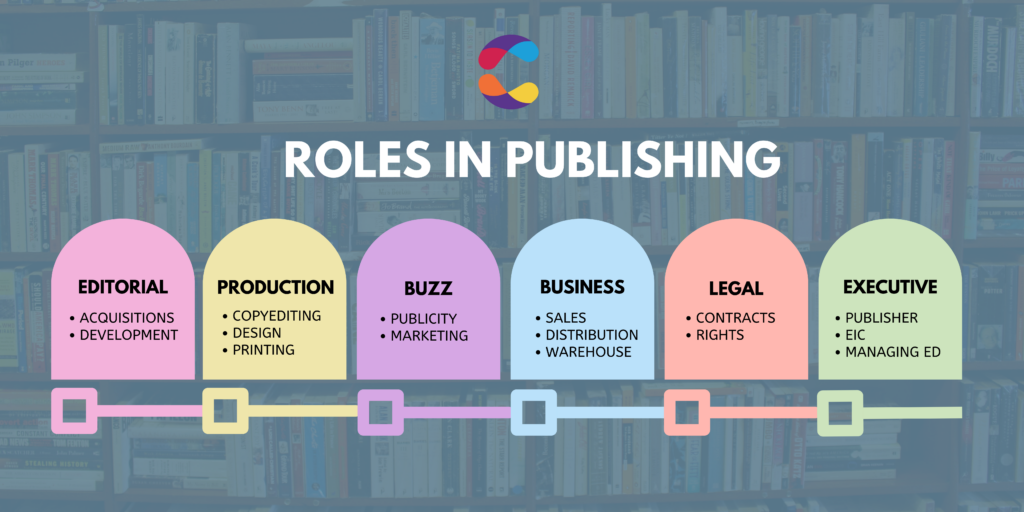Publishing Quickstart Guide: An Overview of Roles in the Publishing Industry

It’s not too far of a venture to say that probably 90, or even 95 percent of the people who are interested in publishing dream of becoming an editor. Editorial is a highly sought-after department—and for good reason: it’s a respectable role, largely aligned with the passion of many publishing hopefuls, and it involves tons of reading (which presumably if you’re looking to enter this industry, you love)! However, there are downsides to editing too: continuous burnout and a lack of work/life balance are two of the biggest challenges that many editors face due to the volume of reading and revising that is expected of them.
If you’re looking to explore other roles in publishing besides editorial, this is a quickstart guide that covers some of the lesser-known roles in editorial plus some other departments frequently found in publishing imprints. Let’s explore these underappreciated roles and expand your horizons!

Acquisitions
Acquisitions editors jumpstart the publishing process. AEs are the ones reading slush and determining what they want to pitch to the rest of the team, usually in a meeting called Pub Board (Publishing Board). This meeting generally includes the rest of the editorial team, plus sales and marketing, and the publisher.
Acquisitions editors are also sometimes the ones that come up with ideas and search for authors to execute the manuscript. In the simplest terms, acquisitions editors are the treasure hunters who get to advocate super hard for the books they believe in.
Development
Development editors are likely the editors that people think of when they think of editors in the publishing industry. Development editors work closely with authors to bring their vision to life. Their primary responsibility is to offer suggestions related to plot, character, writing style, pacing, and worldbuilding to ensure that the book is not only readable but appealing to its intended audience.
Copyediting
Copyeditors are the grammar police who upkeep the literary standards of an imprint! These eagle-eyed editors usually abide by a style guide or imprint handbook. For certain fiction projects but more so for nonfiction titles, copyeditors will be in charge of fact-checking.
Copyeditors generally are hired on an as-needed basis, so you will likely find that most copyediting job listings are more oriented towards freelance than they are full-time, salaried positions. As students of Emerson, you also have the opportunity to apply for the Penguin Random House copyediting mentorship. Upon completion of the mentorship, you will be kept in the network of freelance copyeditors that PRH hires for its projects. Make sure to keep an eye out on your emails for the WLP Announce email regarding the program in every fall!
Design
The design department is an essential part of the publishing team. Depending on the imprint, design can be a combined group or separated into two separate departments: marketing design and book design.
Marketing designers work on graphics and videos for social media or promotional videos. These designers are able to put together enticing graphics and animations, or can easily piece together a set and film an aesthetically pleasing video to use on TikTok. Marketing designers are also sometimes involved in helping establish a publisher’s branding (e.g. the imprint’s logo and signature colors/typography).
Book designers are in charge of laying out the exterior and interior of the book. Interior elements include things like chapter headers, running heads, and typesetting. The exterior of the book features the cover, spine, and back cover. The design team will also oftentimes work with production (to be discussed in the next section) to elevate the book with details like foiling, embossing, or special endpapers for hardbacks. Book designers additionally collaborate with the editorial department to ensure (especially in picture books) that all the content of the book has been transferred into the printing proofs properly without the introduction of new errors. One of the coolest parts of working as a book designer is being able to research and hire freelance illustrators whose styles match the look and feel of the book. These designers truly get to see the book come to life—and are often the ones to see multiple different stunning versions of the book before the best version is selected.
Production
The production team accompanies the book from its digital form to a real, print book. Production editors are absolute nerds about trim sizes, paper weights, colors, cover types (paper over board, cloth w/ just jackets, matte touch, glossy, additional details like stickers, pockets, and ribbon bookmarks). Beyond these details, the production team is also coordinating with printers (usually overseas) to determine the cost of a print run and relaying this information back to the managing editor to run the P&L (profit & loss statement).
Managing Editorial/Operations
The managing editor and operations team in a publishing company is essential for keeping the book moving along the publishing pipeline—they are, quite literally, the glue that keeps all the departments above (and below!) running smoothly.
Managing editors are scheduling experts. Besides running the P&L to get projected numbers for the publishers, they are also the ones creating the schedules that coordinate all the work that editors, writers, and the design/production do into one cohesive picture. Because they’re so involved with ushering each title through the process in a timely manner, managing editors are usually the ones to help determine plausible release dates and make strategic decisions surrounding the timing of a book’s movement through the pipeline.
Publicity
Publicists get the word out about books by collaborating with influencers and media contacts to create buzz! Their day-to-day responsibilities include tasks like researching contacts, writing up compelling pitches, and mailing out ARCs and final copies to appropriate recipients. They may also be responsible for coordinating events for the author—like launch parties, interviews, and signings.
Marketing
The marketing team is behind all those fancy ads you see on billboards and those giveaways you keep entering in the hopes you’ll win. These marketers are experts in paid and organic advertisement—and they love hopping on a trend for social media, sharing timely book recommendations, putting together exciting preorder campaigns. Beyond making the funny TikToks you laugh at during your lunch break, the marketing team also digs into data analytics of backlist titles via data analysis to help increase sales both for new releases and older titles. They’re innovative and always hungry for ways to strategically invest in advertisement resources to put the publisher in the green!
Sales
The sales team is a talkative bunch. Sales coordinates with various customer accounts (retail/special sales/indie) and distributors to get the books into different brick-and-mortar stores or warehouses for online distributors. Members of this team must have great pitching and, you guessed it, selling skills. During sales meetings, they advocate for their imprints’ books and tell buyers why they should stock the book in their stores (e.g. the author has a great track record or a big platform, the book covers a trending topic or similar, older/similar titles have sold well). Brick-and-mortar real estate is expensive, and ideally publishers want their books face out or in prime locations for discovery by consumers as much as possible.
Sales not only connects the book to the consumers, but also to the people who make it easier for consumers to make decisions, like booksellers, bookstore buyers, and more. They will collate catalogs of upcoming releases to build excitement in the retail space, and prep booksellers for advocating for their new favorite book by providing ARCs (advanced reader copies), signed bookplates, postcards, bookmarks, and more!
For the publisher, sales will additionally put together reports to showcase to the rest of the company and inform future acquisitions. Their role is important as the sales team works directly with the data that will allow the imprint to forecast its performance while at the same time predicting anticipated revenue from upcoming releases.
Rights
A publisher’s rights team is always on the lookout for opportunities to take the book from print edition to new formats like film/TV adaptations, licensing, translations into other languages, and more. Rights teams often attend trade rights fairs to pitch books or purchase books and also purchase titles for their lists, which means they’re highly involved in regulating the money that goes in and out of the imprint.
Legal/Contracts
The legal and contracts team are experts on copyright. They can guide you through basically any sort of legal paperwork you might ever need within a publishing context (e.g. giveaway rules with terms and conditions). They’ll also pull together the contracts for authors that outline deliverables, responsibilities, and compensation (e.g. advances, royalties).
Publisher
The role of the publisher is a huge honor as it’s the highest position that you can achieve at an imprint. However, the role is quite challenging as it requires that you have extensive knowledge of all departments plus trends in the industry to help guide acquisitions. As the primary decision-maker of your company/imprint, you must know the imprint’s catalog front-to-back—everything from new releases to old titles that were published before you were even hired. Beyond curating a cohesive catalog, publishers manage the bigger picture tasks that many other departments barely touch—things dealing with the budget and P&L or anything requiring representation from the imprint to the larger company. Their role is a highly involved and highly rewarding one.
Now that you know (almost) all the roles and responsibilities that keep a publishing company on its feet, you should at this point realize that while editorial is a fantastic department to work in, it’s not the end-all-be-all of your publishing career. Many other positions are just as involved and just as rewarding too. Just because you’re unsure if you’re into sales or contracts doesn’t mean it’s not worth giving them a try.
Test the waters—you never know what’s in your next chapter.